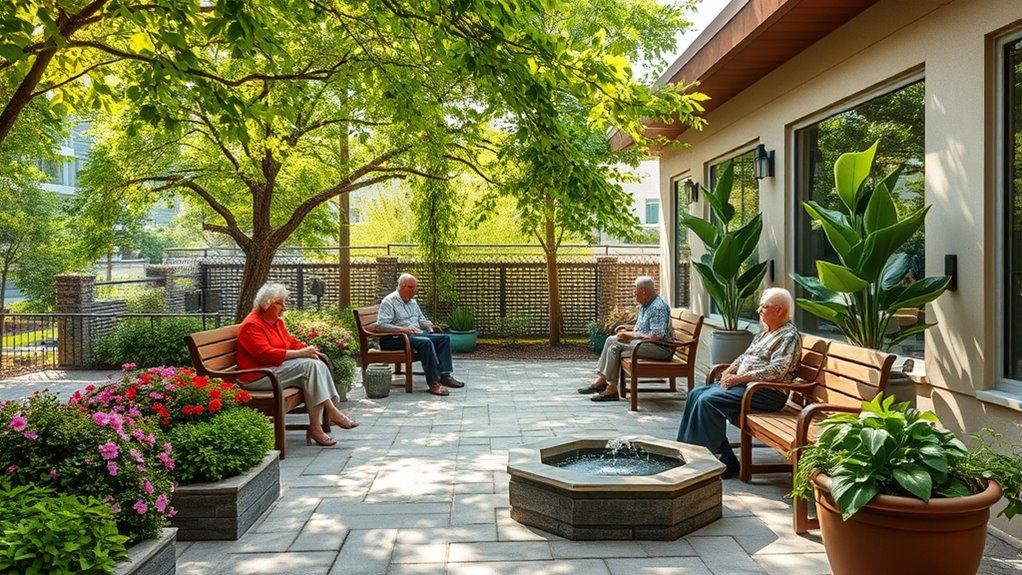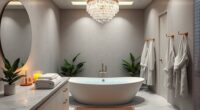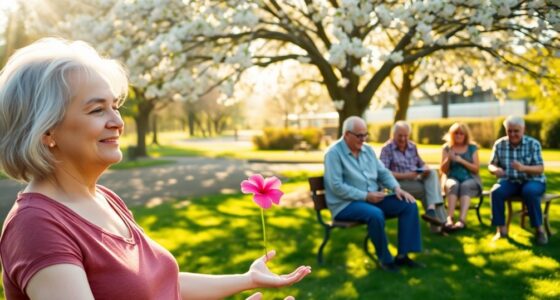Biophilic design uses natural elements like plants, water, and sunlight to create calming environments that lower stress for older adults. When your space includes large windows with greenery views or natural textures, it helps reduce cortisol levels and blood pressure, promoting relaxation. These features encourage mental clarity and emotional well-being, making spaces feel safe and soothing. Keep exploring to discover how incorporating nature can transform your environment and support your overall health.
Key Takeaways
- Incorporating natural views, large windows, and greenery in design reduces cortisol levels and lowers blood pressure in older adults.
- Biophilic elements like plants, water features, and natural textures evoke tranquility, calming the nervous system and reducing mental fatigue.
- Natural visuals and sounds foster emotional well-being, decrease stress, and promote relaxation for seniors in their environments.
- Connecting older adults with nature through design encourages physical activity, social interaction, and a sense of community.
- Creating environments that mimic natural surroundings supports mental clarity, resilience, and healthier aging by reducing stress.

Spending time in nature can considerably reduce your stress levels and improve your overall well-being. When you immerse yourself in natural environments, your body responds by lowering cortisol levels, reducing blood pressure, and calming your nervous system. This natural calming effect isn’t just a fleeting feeling; it has lasting benefits that help you feel more relaxed, focused, and resilient in daily life. For older adults, incorporating biophilic design—an approach that connects built environments with nature—can be especially powerful in managing stress and enhancing quality of life.
Biophilic design emphasizes integrating natural elements into the spaces where you live and spend time. Imagine walking into a room with large windows that let in abundant sunlight and offer views of greenery outside. The presence of plants, natural textures like wood or stone, and water features can evoke feelings of tranquility and safety. These elements stimulate your senses and create an environment that feels familiar and soothing, which can substantially lower anxiety and promote mental clarity. When your surroundings mimic nature, your brain perceives a sense of calm that reduces the mental fatigue often experienced in traditional, more sterile environments.
For older adults, this design approach can be a game-changer. It provides opportunities for regular contact with nature without the need to venture far outside. Even small touches, such as a balcony garden or a cozy corner with potted plants, can make a big difference in how you feel. These natural features not only reduce stress but also encourage movement and interaction, which are essential for emotional and physical health. When you see greenery or hear sounds of water, your body instinctively responds with relaxation responses, easing tension accumulated throughout the day.
Furthermore, biophilic design fosters a sense of connection—both to nature and to your community. When your environment incorporates natural elements, it can boost your mood and sense of belonging. This connection helps combat feelings of isolation or loneliness, which are common concerns among older adults. As you spend more time in spaces that reflect the natural world, your stress levels decrease, and you’re more likely to engage in social activities, outdoor walks, or quiet reflection. These activities further reinforce your well-being, creating a positive feedback loop that supports healthier aging.
In essence, designing your surroundings with nature in mind isn’t just about aesthetics; it’s a practical strategy to lower stress and promote mental health. By surrounding yourself with natural elements, you tap into a universal source of calm, helping you navigate life’s challenges with greater ease, especially as you age.
Frequently Asked Questions
How Does Biophilic Design Specifically Benefit Mental Health in Seniors?
Biophilic design boosts your mental health by creating spaces that connect you with nature, which reduces stress and anxiety. When you’re surrounded by natural light, greenery, and outdoor views, your mood improves, and feelings of calmness increase. These features help you feel more relaxed and engaged, encouraging mental clarity and emotional stability. Overall, biophilic design makes your environment more comforting, supporting your well-being and helping you manage daily challenges better.
Are There Any Risks Associated With Introducing Natural Elements Into Senior Living Spaces?
You should be aware that introducing natural elements into senior living spaces can pose some risks, such as allergies to pollen or mold, which may affect residents’ health. Additionally, if plants aren’t properly maintained, they could harbor pests or become a safety hazard. To reduce these risks, choose non-toxic, hypoallergenic plants and ensure regular upkeep. With careful planning, biophilic design can be both beautiful and safe for older adults.
What Cost-Effective Methods Can Facilities Implement for Biophilic Environments?
You can implement cost-effective biophilic environments by adding potted plants and hanging greenery, which are affordable and easy to maintain. Use natural light through window treatments and skylights to enhance space without high expenses. Incorporate nature-inspired artwork and colors to evoke calming effects. Create outdoor gardens or communal green spaces using existing land, and encourage residents to tend plants, fostering engagement and natural connection without significant costs.
How Do Individual Preferences Influence the Effectiveness of Nature-Based Design?
You might think one-size-fits-all nature designs work, but your individual preferences shape how effective they are. Ironically, what soothes one person could bore or stress another. You’ll find that customizing elements—like plants, lighting, or views—creates a more calming environment. When you adapt spaces to your tastes, you’ll notice less stress and more comfort, proving that nature’s healing power is truly personal.
Can Biophilic Design Be Adapted for Seniors With Mobility Limitations?
Yes, biophilic design can be adapted for seniors with mobility limitations. You can incorporate accessible features like wide, flat walkways, low-rise planters, and seating areas close to natural elements. Use non-slip surfaces and guarantee easy access to outdoor views. By tailoring the environment to their needs, you help seniors enjoy the benefits of nature, reducing stress and promoting well-being without requiring extensive movement.
Conclusion
So, here’s the irony: while we often chase high-tech solutions to reduce stress, simply bringing nature into your space might be the most effective and effortless fix. You’d think in a world obsessed with gadgets, we’d forget that nature’s calming touch is right outside our door—or even inside. Embracing biophilic design isn’t just good for older adults; it’s a gentle reminder that sometimes, the best stress relievers are the ones we overlook the most.









